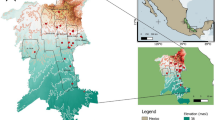Summary
The characterization and evaluation of agroforestry systems is exemplified for the Acosta-Puriscal region in Costa Rica.
After the physio-biological and socio-economic description of the study region, it was stratified into two homogenous areas, and the prevailing agroforestry systems classified into the principal groups: 1. coffee and trees, 2. pasture and trees and, 3. live fences.
The analysis of agroforestry production systems recognizes the following steps: Identification of farmers' production objectives, identification of the elements in the system, study of relationships between elements, analysis of the performance of the system, and, finally, the analysis of production incentives of agroforestry systems.
Whereas classification of agroforestry systems has to be carried out according to the specific site conditions, the methodological approach used to analyse them can be applied generally.
First results of the analysis on coffee in combination with trees indicates that the coffee varietycaturra has a high production potential also in combination with trees. With an increasing number of shade and fruit trees, costs of external inputs can be slightly decreased. With an increased density of trees, however, coffee yields were decreased. Incremental yields of other crops and reduced costs of external inputs off-sets the loss in coffee-production.
Zusammenfassung
Die Charakterisierung und Beurteilung von agroforstwirtschaftlichen Anbausystemen wird am Beispiel der Region Acosta-Puriscal in Costa Rica, dargestellt.
Nach einer physisch-biologischen und sozio-ökonomischen Beschreibung der Untersuchungsregion wurde das Gesamtgebiet in zwei relativ homogene Zonen aufgeteilt und die vorhandenen agroforstwirtschaftlichen Anbausysteme in ihre wichtigsten Gruppen klassifiziert: 1. Kaffee und Bäume, 2. Weide und Bäume, und 3. lebende Zäune.
Die Analyse und Evaluierung der Anbausysteme erfolgt in folgenden Schritten: Zielanalyse, Identifizierung der wesentlichen Elemente, Untersuchung der Beziehungen zwischen den Elementen, Analyse der Zielerreichung und schliesslich Analyse der vorhandenen Produktionsanreize für agroforstwirtschaftliche Systeme. Während die Klassifizierung der Systeme immer lokalspezifisch durchgeführt werden muss, scheint das methodische Vorgehen der Analyse allgemein praktizierbar zu sein.
Die ersten Ergebnisse des Anbausystems ‘Kaffee und Bäume’ deuten darauf hin, dass die Kaffee-Varietät ‘Caturra’ in Verbindung mit Bäumen ein hohes Produktionspotential hat. Bei einem vermehrten Einsatz von Schatten — und Fruchtbäumen können die Kosten für, ‘externe inputs’ leicht verringert werden. Bei einer Kombination von Kaffee + Schatten + Fruchtbäume sinkt die Kaffeeproduktion der Varietät Caturra um etwa 14% ab, das Nettoeinkommen pro ha verringert sich jedoch nicht dank der zusätzlichen Produktion der Bäume und der insgesamt niedrigeren Produktionskosten.
Similar content being viewed by others
Bibliography
Bertalanffy L von (1973) General system theory: Foundations — development — applications, Rev. Ed. New York: G Braziller
BID (1977) (Banco Intermericano de Desarrollo) Informe General sobre el Desarrollo Agropecuario y Rural de Costa Rica, División de Estudios Generales, Departamento de Desarrollo Económico y Social, San José
Bonilla A (1979) La Deforestación en Puriscal — Proceso Histórico, Procencia, Publicación Bimestral del Consejo Nacional de las Investigaciones Científicas y Tecnológicas, No 20, San José
Combe J, Budowski G (1979) Classification of agroforestry techniques. In: Proceedings of Workshop on Agroforestry systems in Latin America. Turrialba: CATIE
Contant R (1982) Editorial. In: Agroforestry Syst 1 (1):10–11
Hargreaves G (1976) Tables showing climate and potential evapotranspiration for Central America. Utah State University
Hart RD (1979) An ecological system conceptual framework of agricultural research and development. Turrialba: CATIE
Heuveldop J, Chang B (1981) Agroforestry for improvements of deforested mountain lands in Costa Rica. Turrialba: CATIE
Holdridge, LR (1967) Life zone ecology, 2nd ed. Tropical Science Center, San José, Costa Rica
Lagemann J (1982) Farming systems research as a tool for identifying and conducting research and development projects. In: Agric Admin (accepted for publication on February, 1982)
Platen H von, Lagemann J (1981) Agricultural production in Acosta-Puriscal, Costa Rica. Techn Ser No 13. Turrialba: CATIE
Platen H von, Rodriguez G, Lagemann J (1982) Farming systems in Acosta-Puriscal, Costa Rica. Turrialba: CATIE (in preparation)
Ruthenberg H (1980) Farming systems in the tropics, 3rd ed. Oxford: Clarendon Press
Sauer JA (1979) Living fences in Costa Rican agriculture. In: Turrialba (Costa Rica) 29 (4):255–261
Schaefer-Kehnert W (1979) Measuring small farmers' investment incentives. Course Note Ser 58. Washington: World Bank
Thrupp LA (1980) Deforestation, agricultural development, and cattle expansion in Costa Rica. MSc Thesis, Stanford University
Author information
Authors and Affiliations
Additional information
Agricultural Economist
Agro-Silviculturist Forest Expert
Projects: Farming Systems and Agroforestry at the Centro Tropical de Investigation y Enseñomza in cooperation with the German Agency for Technical Cooperation (GTZ), Eschborn/W. Germany
Rights and permissions
About this article
Cite this article
Lagemann, J., Heuveldop, J. Characterization and evaluation of agroforestry systems: the case of Acosta-Puriscal, Costa Rica. Agroforest Syst 1, 101–115 (1983). https://doi.org/10.1007/BF00596352
Issue Date:
DOI: https://doi.org/10.1007/BF00596352




